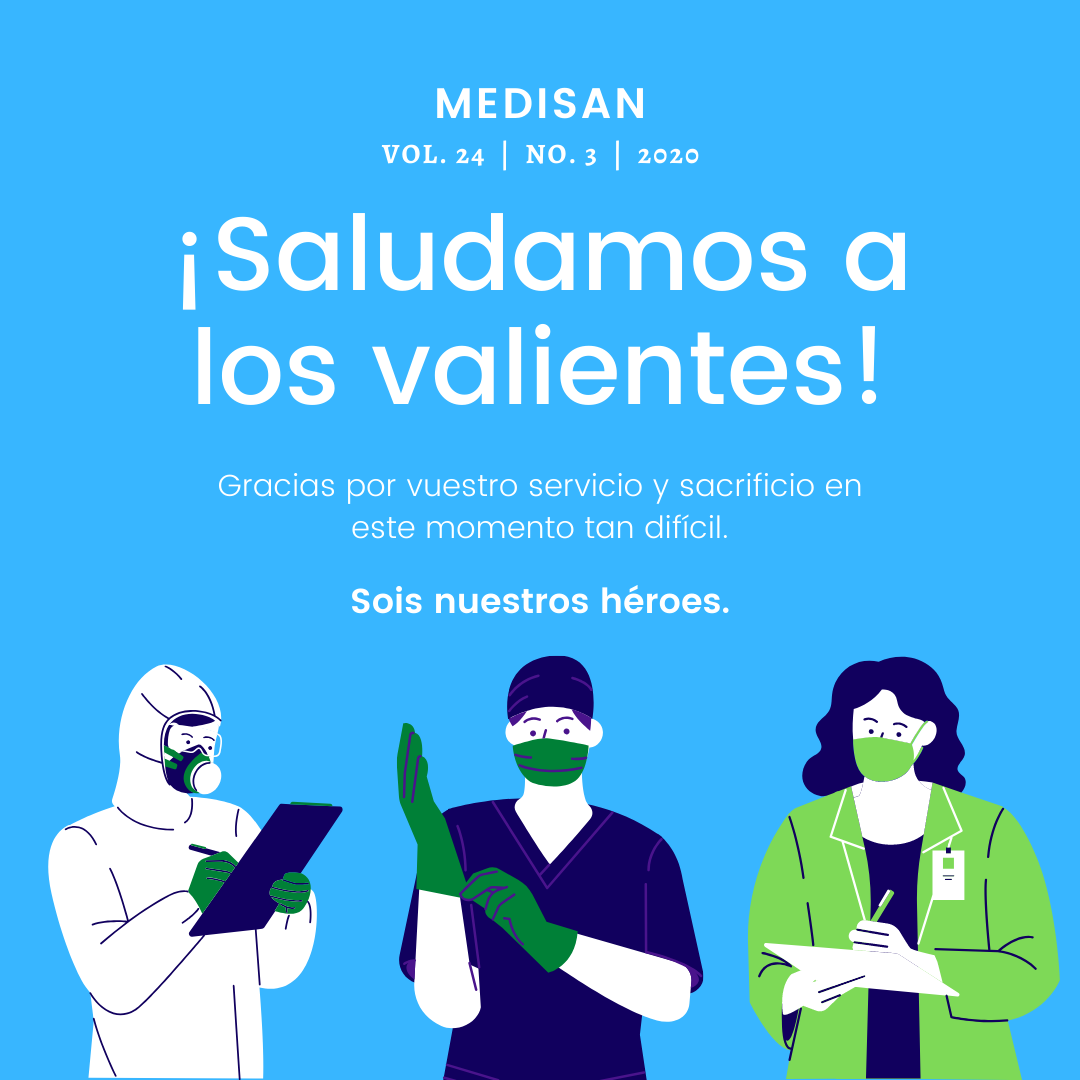Characterization of patients with stroke in an emergency service from Santiago de Cuba
Keywords:
neurological deficit, ischemic stroke, hemorrhagic stroke, Emergencies Service.Abstract
Introduction: The stroke is the neurological damage that happens when one of the brain blood vessels is obstructed by a clot (embolism or clot) or it breaks (hemorrhages), which doesn't allow the brain blood flow.
Objective: To characterize the patients with stroke assisted in the Emergencies Service of Dr. Joaquín Castillo Duany Teaching Clinical Surgical Hospital in Santiago de Cuba.
Methods: A descriptive and cross-sectional study of 122 patients with stroke assisted in the mentioned Service from October, 2016 to the same month in 2017 was carried out. Demographic variables of interest related to the disease were taken into account and the percentage as summary measure was used.
Results: The female sex (58.2 %) and 61-70 age group prevailed in the series. It was demonstrated that 26.2 % of those affected stayed more than 6 hours in the Emergencies Service and it was found an association of this disease with hypertension, diabetes mellitus, ischemic heart disease, nicotine addiction, alcoholism and hyperlipemia; equally, the inadequate use of the pharmacological treatment and the mechanic artificial ventilation caused a high lethality rate.
Conclusions: In spite of the studies carried out in this same institution, it is important to continue deepening in the appropriate control and follow up of these accidents, as well as to develop strategies that allow training and preparation of the medical and paramedic staff of that hospital.
Downloads
References
2. Cabrera Zamora JL. Factores de riesgo y enfermedad cerebrovascular. Rev Cubana Angiol Cir Vasc. 2014 [citado 15/02/2019];15(2):75-88. Disponible en: http://scielo.sld.cu/scielo.php?script=sci_arttext&pid=S1682-00372014000200003
3. Li L, Yiin G, Geraghty O, Schulz U, Kuker W, Mehta Z. Incidence, outcome, risk factors, and long-term prognosis of cryptogenic transient ischaemic attack and ischaemic stroke: a population-based study. Lancet Neurol. 2015;14(9):90313.
4. Wolf ME, Grittner U, Böttcher T, Norrving B, Bolfs A, Hennerici MG. Phenotypic ASCO characterization of young patients with ischemic stroke in the prospective multicentre observational sifap1 study. Cerebrovasc Dis. 2015;40(3/4):12935.
5. Mohr J. Some clinical aspects of acute stroke. Inst J Cardiol. 1997 [citado 15/02/2019];28(9). Disponible en: https://www.ahajournals.org/doi/10.1161/01.STR.28.9.1835
6. Norris JW, Hachinski VC. Intensive care management of stroke patients. Stroke. 1976;7(6):573-6.
7. Acampa M, Guideri F, Tassi R, Dello Buono D, Celli L, di Toro Mammarella L. P wave dispersion in cryptogenic stroke: a risk factor for cardioembolism? Int J Cardiol. 2015;190:2024.
8. Kent M, Dahabreh I, RuthazerR, Furlan A, Weimar C, Serena J. Anticoagulant vs. antiplatelet therapy in patients with cryptogenic stroke and patent foramen ovale: an individual participant data meta-analysis. Eur Heart J. 2015;36(35):23819.
9. Avezum A, Costa Filho FF, Pieri A, Martins SO, Marin Neto JA. Stroke in Latin America. Burden of disease and opportunities for prevention. Glob Heart. 2015 [citado 15/02/2019]; 10(4). Disponible en: http://www.sciencedirect.com/science/article/pii/S2211816014000180.
10. Albers GW. Rationales for early intervention in acute stroke. Am J Cardiol. 1997;80(4):35-9.
11. Herrera AL, Góngora RF, Muruet W, Villarreal HJ, Gutiérrez HM, Huerta L, et al. Investigators. Implementation of a stroke registry is associated with an improvement in stroke performance measures in a tertiary hospital in Mexico. J Stroke Cerebrovasc Dis. 2015;24(4):725-30.
12. Acampa M, Guideri F, Tassi R, Lo Giudice G, D'Andrea P, Martini G, et al. P wave dispersion in cryptogenic stroke: A risk factor for cardioembolism? Int J Cardiol. 2015;190:2024.
13. Bahit C, Coppola M, Riccio P, Ciprinao L, Roth G, Lopes R, et al. First-ever stroke and transient ischemic attack incidence and 30-day case-fatality rates in a population-based study in Argentina. Stroke. 2016; 47: 1640-2.
14. Valhuerdi Cerero AJ, Llibre Guerra JJ, Valhuerdi Porto C, Porto Álvarez RB, Muñoz Rodríguez R, Muñoz Rodríguez M. Disfunción cerebral focal vascular en adultos mayores de la comunidad. Prevalencia, factores de riesgo aterogénico y manejo. Rev Med Electrón. 2015 [citado 15/02/2019];37(5):452-68. Disponible en: http://scielo.sld.cu/scielo.php?script=sci_arttext&pid=S1684-18242015000500005
15. De Dios Perera C, López Domínguez A, Rosales Rosales D, Rodríguez Sánchez VZ. Morbilidad y mortalidad en pacientes egresados de la unidad de cuidados intensivos de Contramaestre durante un bienio. MEDISAN. 2013 [citado 15/02/2019];17(5). Disponible en: http://scielo.sld.cu/scielo.php?script=sci_arttext&pid=S1029-30192013000500002
16. Toledo Hernández JM, Toledo Guillan EM, Quesada Leyva L, López Corderí D, Curbelo Toledo M. Comportamiento de los factores de riesgo modificables después del primer evento agudo de la enfermedad cerebro-vascular. AMC. 2016 [citado 15/02/2019];20(5). Disponible en: http://scielo.sld.cu/scielo.php?script=sci_arttext&pid=S1025-02552016000500008&lng=es&nrm=iso&tlng=es
17. Torres Maceo JM, Pérez Castillo S, Soto González R. Características clinicoepidemiológicas de pacientes ingresados por enfermedad cerebrovascular en una unidad de cuidados intensivos. MEDISAN. 2015 [citado 15/02/2019];19(9). Disponible en: http://scielo.sld.cu/scielo.php?script=sci_arttext&pid=S1029-30192015000900004&lng=es&nrm=iso&tlng=es
18. WHO. Health in the post-2015 development agenda: need for a social determinant of health approach [citado 15/02/2019]. Disponible en: https://www.who.int/social_determinants/advocacy/UN_Platform_FINAL.pdf?ua=1
Published
How to Cite
Issue
Section
License
All the articles can be downloaded or read for free. The journal does not charge any amount of money to the authors for the reception, edition or the publication of the articles, making the whole process completely free. Medisan has no embargo period and it is published under the license of Creative Commons, International Non Commercial Recognition 4.0, which authorizes the copy, reproduction and the total or partial distribution of the articles in any format or platform, with the conditions of citing the source of information and not to be used for profitable purposes.





